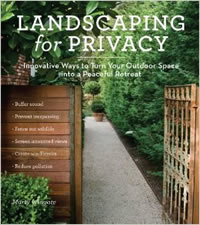Could you recommend some plants for a privacy screen that are also narrow? These would be planted in front of a fence in our backyard.
Here is some general information on plants for creating a screen.
Trees for Problem Landscape Sites — Screening from Virginia Cooperative Extension
Bet on Hedges by local garden writer Valerie Easton.
Landscaping for Privacy: Innovative Ways to Turn Your Outdoor Space into a Peaceful Retreat by PNW author Marty Wingate.
Here is a list of narrow plants for a screen from local garden designer Chris
Pfeiffer: “Fastigiate shrubs for naturally narrow hedges.” Compiled by Chris
Pfeiffer. 2005.
Zones 5-6:
American arborvitae ‘Rheingold’ (Thuja occidentalis ‘Rheingold’) 5’h x
3’w
Barberry ‘Helmond Pillar’ (Berberis thunbergii f. atropurpurea
‘Helmond Pillar’) 6’h x 2’w
Boxwood ‘Graham Blandy’ (Buxus sempervirens ‘Graham Blandy’) 8’h x 1-1/2′
w
English yew ‘Standishii’ (Taxus baccata ‘Standishii’) 4’h x 1-1/2′ w
Irish yew (Taxus baccata ‘Fastigiata’) 20′ h x 4′ w
Japanese holly Jersey pinnacle (Ilex crenata ‘Jersey Pinnacle’) 6′ h x
4′ w
Japanese holly Mariesii (Ilex crenata ‘Mariesii’) 3′ h x 1-1/2′ w
Zones 7-9, in addition to the above:
Dwarf yeddo rhaphiolepis (Rhaphiolepis umbellata Gulf GreenTM) 3-4′ h x
2′ w
Heavenly bamboo ‘Gulf Stream’ (Nandina domestica ‘Gulf Stream’) 4′ h x 2′ w
Japanese euonymus ‘Green Spire’ (Euonymus japonicus ‘Green Spire’) 15′ h x
6′ w
You might also consider installing a trellis to increase the height of
the fence, and then growing an evergreen vine such as Clematis armandii,
evergreen hydrangea (Hydrangea seemanii), or star jasmine
(Trachelospermum jasminoides).
This link is also helpful (scroll down to
“Evergreen Vines” and look for appropriate height and light requirements).
You could grow bamboo, but I would recommend growing it in a container,
or a series of containers, as you do not want the roots to spread. I have
seen an effective bamboo screen between two houses growing in a long
rectangular lined wooden trough (lined with bamboo barrier). Some species
of bamboo are more tolerant of partial shade than others. Look for a
clumping, rather than a running, bamboo (like Fargesia) to be on the safe
side.
 “Landscaping for Privacy” by Marty Wingate is very practical and addresses annoying issues like siting the recycle bins, and how to embrace wildlife or pets without letting them run amok, while empowering you to create a space that is very distinctly your own. Relatively few gardening books address fences and hedges in any depth, but for Wingate “screening hedges become more than shrubs planted in a line; they create a green, living wall, incorporating the design elements of sequence and repetition to pull together the landscape.”
“Landscaping for Privacy” by Marty Wingate is very practical and addresses annoying issues like siting the recycle bins, and how to embrace wildlife or pets without letting them run amok, while empowering you to create a space that is very distinctly your own. Relatively few gardening books address fences and hedges in any depth, but for Wingate “screening hedges become more than shrubs planted in a line; they create a green, living wall, incorporating the design elements of sequence and repetition to pull together the landscape.”